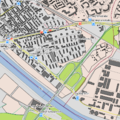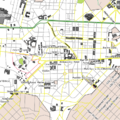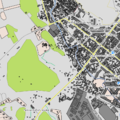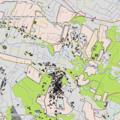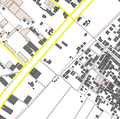OSMaxx: Unterschied zwischen den Versionen
Stefan (Diskussion | Beiträge) K |
Das-g (Diskussion | Beiträge) (→Documentation: update link to schema documentation) |
||
| (21 dazwischenliegende Versionen von 2 Benutzern werden nicht angezeigt) | |||
| Zeile 1: | Zeile 1: | ||
[[Bild:Osmaxx_Logo.png|200px||right|link=http://osmaxx.hsr.ch]] | [[Bild:Osmaxx_Logo.png|200px||right|link=http://osmaxx.hsr.ch]] | ||
| − | '''"OSM Arbitrary Excerpt Export"''' ( | + | '''"OSM Arbitrary Excerpt Export"''' (OSMaxx) [[Datei:Osmaxx_Logo_16x16.png]] |
| − | + | >> Homepage http://osmaxx.hsr.ch/ << | |
| − | |||
| − | '' | + | ''(ENGLISH) Get the OpenStreetMap data you want in the file format you need! - Geospatial data from the unique and worldwide [[OpenStreetMap]] project, prepared für map visualization and analyses in GIS. |
| − | + | Cuts out (extracts or excerpts) [[OpenStreetMap]] data, processes it to geodata and converts it to typical [[GIS]] fileformats before being prepared for download.'' | |
| − | === Weblinks === | + | "OpenStreetMap-Daten für GIS frei herunterladen, detailreich, weltweit!" - Geodaten des einzigartigen und weltweiten OpenStreetMap-Projekts aufbereitet für Kartenvisualisierung und Analyse in GIS. |
| − | * | + | Schneidet [[OpenStreetMap]]-Daten aus, bereitet sie zu Geodaten auf und stellt sie in verschiedenen gängigen [[GIS]]-Fileformaten zum Download zur Verfügung. |
| + | |||
| + | '''Die Vorteile auf einen Blick:''' | ||
| + | # Weltweite Vektordaten für GIS aufbereitet | ||
| + | # Selber definierte Ausschnitte über Ländergrenzen hinweg | ||
| + | # Hochaktuell (Stunden) | ||
| + | # Sehr umfangreicher Inhalt and Objekten (z.B. Gebäudehöhen, Strassenbelag, Sitzbänke, etc.) | ||
| + | |||
| + | Details: | ||
| + | * Das Zielschema umfasst Geometrien (Punkt, Linestring, Polygon) sowie ein GIS-Datenmodell mit über 22 Tabellen/Layers (z.B. Highways, Railways, Buildings, etc.). | ||
| + | * Verfügbare GIS-Fileformate zur Abgabe sind GeoPackage, Shapefle, File Geodatabase, OSM PBF sowie ein Navi-Format (Garmin .IMG). | ||
| + | * Das Navi-Format (Garmin) enthält routingfähige Strassen. | ||
| + | * Es werden auch Karten-Symbologien für QGIS und ArcGIS abgegeben, passend zu den GIS-Fileformaten. | ||
| + | * Die Bearbeitung dauert je nach Grösse des Ausschnitts ca. 30 min. | ||
| + | * Zur Aufbereitung gehört, dass die heterogenen OSM-Daten homogenisiert werden (z.B. Restaurants als Punktobjekte, auch wenn sie in OSM als Gebäudefläche erfasst wurden). Damit können bis zu einem Drittel mehr Informationen aus OMS herausgeholt werden im Vergleich zu den Rohdaten und zu einfachen Konvertern. | ||
| + | |||
| + | === Useful Weblinks === | ||
| + | * For availability and performance status see e.g. https://twitter.com/geometalab | ||
* Repository (Source Code, Ticketing): https://github.com/geometalab/osmaxx | * Repository (Source Code, Ticketing): https://github.com/geometalab/osmaxx | ||
* IFS internal (login required): https://wiki.ifs.hsr.ch/IfSwWiki/wiki.cgi?Osmaxx | * IFS internal (login required): https://wiki.ifs.hsr.ch/IfSwWiki/wiki.cgi?Osmaxx | ||
| Zeile 15: | Zeile 31: | ||
=== Project === | === Project === | ||
| − | Project staff | + | Project staff (mainly from Geometa Lab HSR): |
* Stefan: Lead and concept | * Stefan: Lead and concept | ||
| − | * | + | * Raphael: Coordination, integration, frontend and backend |
* Tobias: Frontend (Javascript, ...) | * Tobias: Frontend (Javascript, ...) | ||
| − | * Nicola: Backend (Python, | + | * Nicola: Backend (Python, PostgreSQL, ...) |
| − | * | + | |
| + | Former staff members: | ||
| + | * Simran: several enhancements | ||
| + | * Dhruv: PostGIS loading and schema transformation/data homogenization | ||
| + | * Van An: QGIS symbology | ||
| + | * Eugene: PostGIS loading and schema transformation/data homogenization | ||
* Lukas: Extraction tool chain (Linux tools, ...) | * Lukas: Extraction tool chain (Linux tools, ...) | ||
* Martin: ArcGIS symbology (ArcGIS) | * Martin: ArcGIS symbology (ArcGIS) | ||
| Zeile 26: | Zeile 47: | ||
=== Map Gallery === | === Map Gallery === | ||
| − | This gallery shows some maps made with | + | This gallery shows some maps made with OSMaxx data using QGIS styling (see also [[Making Maps from OpenStreetMap Data]]): |
<gallery> | <gallery> | ||
Datei:Rapperswil_square.png|Rapperswil (Switzerland) | Datei:Rapperswil_square.png|Rapperswil (Switzerland) | ||
| Zeile 36: | Zeile 57: | ||
Datei:Gaza_square.png|Gaza (Palestine) | Datei:Gaza_square.png|Gaza (Palestine) | ||
</gallery> | </gallery> | ||
| − | |||
| − | |||
| − | |||
| − | |||
| − | |||
| − | |||
| − | |||
| − | |||
| − | |||
| − | |||
| − | |||
| − | |||
| − | |||
| − | |||
| − | |||
| − | |||
=== Documentation === | === Documentation === | ||
| − | End user oriented documents and files of | + | End user oriented documents and files of OSMaxx project (download tbd.): |
* "Internal" | * "Internal" | ||
** Data Model inc. Catalog of Objects/Entities (OSMaxx_Data_Model.odt) (=> see also https://github.com/geometalab/osmaxx-docs) | ** Data Model inc. Catalog of Objects/Entities (OSMaxx_Data_Model.odt) (=> see also https://github.com/geometalab/osmaxx-docs) | ||
| Zeile 68: | Zeile 73: | ||
Symbology "M2" and "M3" (tbd.) | Symbology "M2" and "M3" (tbd.) | ||
| − | ** ... | + | * ... |
| + | |||
| + | Data Model: | ||
| + | * See Discussion | ||
| + | * [https://github.com/geometalab/osmaxx/blob/master/docs/osmaxx_data_schema.md Export Schema Documentation] (on Github). | ||
| + | |||
| − | + | [[Kategorie:Geodaten]] | |
| − | + | [[Kategorie:GIS]] | |
| − | + | [[Kategorie:OpenStreetMap]] | |
| − | |||
| − | |||
| − | |||
| − | |||
| − | |||
| − | |||
| − | |||
| − | |||
| − | |||
| − | |||
| − | |||
| − | |||
| − | |||
| − | |||
| − | |||
| − | |||
| − | |||
| − | |||
| − | |||
| − | |||
| − | |||
| − | |||
| − | |||
| − | |||
| − | |||
| − | |||
| − | |||
| − | |||
| − | |||
| − | |||
| − | |||
| − | |||
| − | |||
| − | |||
| − | |||
| − | |||
| − | |||
| − | |||
| − | |||
| − | |||
| − | |||
| − | |||
| − | |||
| − | |||
| − | |||
| − | |||
| − | |||
| − | |||
| − | |||
| − | |||
| − | |||
| − | |||
| − | |||
| − | |||
| − | |||
| − | |||
| − | |||
| − | |||
| − | |||
| − | |||
| − | |||
| − | |||
| − | |||
| − | |||
Version vom 6. September 2017, 13:37 Uhr
"OSM Arbitrary Excerpt Export" (OSMaxx) ![]()
>> Homepage http://osmaxx.hsr.ch/ <<
(ENGLISH) Get the OpenStreetMap data you want in the file format you need! - Geospatial data from the unique and worldwide OpenStreetMap project, prepared für map visualization and analyses in GIS. Cuts out (extracts or excerpts) OpenStreetMap data, processes it to geodata and converts it to typical GIS fileformats before being prepared for download.
"OpenStreetMap-Daten für GIS frei herunterladen, detailreich, weltweit!" - Geodaten des einzigartigen und weltweiten OpenStreetMap-Projekts aufbereitet für Kartenvisualisierung und Analyse in GIS. Schneidet OpenStreetMap-Daten aus, bereitet sie zu Geodaten auf und stellt sie in verschiedenen gängigen GIS-Fileformaten zum Download zur Verfügung.
Die Vorteile auf einen Blick:
- Weltweite Vektordaten für GIS aufbereitet
- Selber definierte Ausschnitte über Ländergrenzen hinweg
- Hochaktuell (Stunden)
- Sehr umfangreicher Inhalt and Objekten (z.B. Gebäudehöhen, Strassenbelag, Sitzbänke, etc.)
Details:
- Das Zielschema umfasst Geometrien (Punkt, Linestring, Polygon) sowie ein GIS-Datenmodell mit über 22 Tabellen/Layers (z.B. Highways, Railways, Buildings, etc.).
- Verfügbare GIS-Fileformate zur Abgabe sind GeoPackage, Shapefle, File Geodatabase, OSM PBF sowie ein Navi-Format (Garmin .IMG).
- Das Navi-Format (Garmin) enthält routingfähige Strassen.
- Es werden auch Karten-Symbologien für QGIS und ArcGIS abgegeben, passend zu den GIS-Fileformaten.
- Die Bearbeitung dauert je nach Grösse des Ausschnitts ca. 30 min.
- Zur Aufbereitung gehört, dass die heterogenen OSM-Daten homogenisiert werden (z.B. Restaurants als Punktobjekte, auch wenn sie in OSM als Gebäudefläche erfasst wurden). Damit können bis zu einem Drittel mehr Informationen aus OMS herausgeholt werden im Vergleich zu den Rohdaten und zu einfachen Konvertern.
Inhaltsverzeichnis
Useful Weblinks
- For availability and performance status see e.g. https://twitter.com/geometalab
- Repository (Source Code, Ticketing): https://github.com/geometalab/osmaxx
- IFS internal (login required): https://wiki.ifs.hsr.ch/IfSwWiki/wiki.cgi?Osmaxx
Project
Project staff (mainly from Geometa Lab HSR):
- Stefan: Lead and concept
- Raphael: Coordination, integration, frontend and backend
- Tobias: Frontend (Javascript, ...)
- Nicola: Backend (Python, PostgreSQL, ...)
Former staff members:
- Simran: several enhancements
- Dhruv: PostGIS loading and schema transformation/data homogenization
- Van An: QGIS symbology
- Eugene: PostGIS loading and schema transformation/data homogenization
- Lukas: Extraction tool chain (Linux tools, ...)
- Martin: ArcGIS symbology (ArcGIS)
Map Gallery
This gallery shows some maps made with OSMaxx data using QGIS styling (see also Making Maps from OpenStreetMap Data):
Documentation
End user oriented documents and files of OSMaxx project (download tbd.):
- "Internal"
- Data Model inc. Catalog of Objects/Entities (OSMaxx_Data_Model.odt) (=> see also https://github.com/geometalab/osmaxx-docs)
- Common fonts and symbols
- Font "Deja Vu"
- Point Symbols (.svg + .png)
Symbology "M1" (meaning optimized for scale 1:2.500, i.e.1:1.000 to 1:10.000)
- Symbol Catalog for "M1" (OSMaxx_SymbolCatalog.xlsx) (=> see also https://github.com/geometalab/osmaxx-docs)
- ArcGIS (.mdx/.lyr)
- QGIS (.qgs)
Symbology "M2" and "M3" (tbd.)
- ...
Data Model:
- See Discussion
- Export Schema Documentation (on Github).


